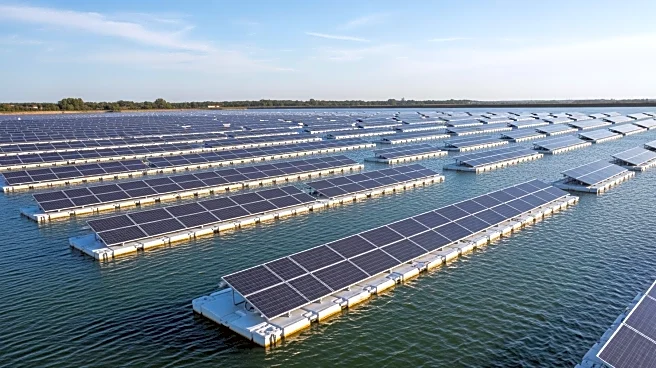What's Happening?
Texas is set to host a 391-megawatt floating solar power plant, marking a significant development in the U.S. renewable energy sector. The project, known as the Pleasure Island Power Collective, will be
constructed in Port Arthur, Texas, and will occupy 2,275 acres on Sabine Lake and Pleasure Island. This initiative is spearheaded by Diligence Offshore Services, a startup that aims to integrate wind, solar, and energy storage under one collective. The floating solar plant is expected to be the largest of its kind in the U.S., surpassing previous projects in scale and ambition. The project is part of a broader effort to enhance energy independence and economic growth in the region, without relying on federal subsidies or tax abatements.
Why It's Important?
The introduction of a large-scale floating solar power plant in Texas represents a pivotal shift in the U.S. renewable energy landscape. Floating solar technology offers unique advantages, such as conserving land space and potentially benefiting aquatic ecosystems by reducing water evaporation and algae growth. This project could set a precedent for future developments in the sector, encouraging more states to explore similar initiatives. The economic implications are significant, as the project promises to boost local employment and contribute to the state's renewable energy capacity, positioning Texas as a leader in the transition to clean energy.
What's Next?
The Pleasure Island Power Collective is expected to proceed with construction, leveraging the expertise of AccuSolar for the floating solar technology. The project aims to accelerate development through the federal Defense Production Act, although it does not depend on federal approval or support. As the project progresses, it may inspire other states to consider floating solar solutions, potentially leading to increased investment and innovation in the renewable energy sector.
Beyond the Headlines
Floating solar technology could have broader implications for environmental conservation and agricultural practices. By utilizing water surfaces for solar panels, land can be preserved for other uses, such as agriculture or ecosystem restoration. This approach aligns with global efforts to balance energy production with environmental sustainability, offering a model for integrating renewable energy with ecological preservation.












